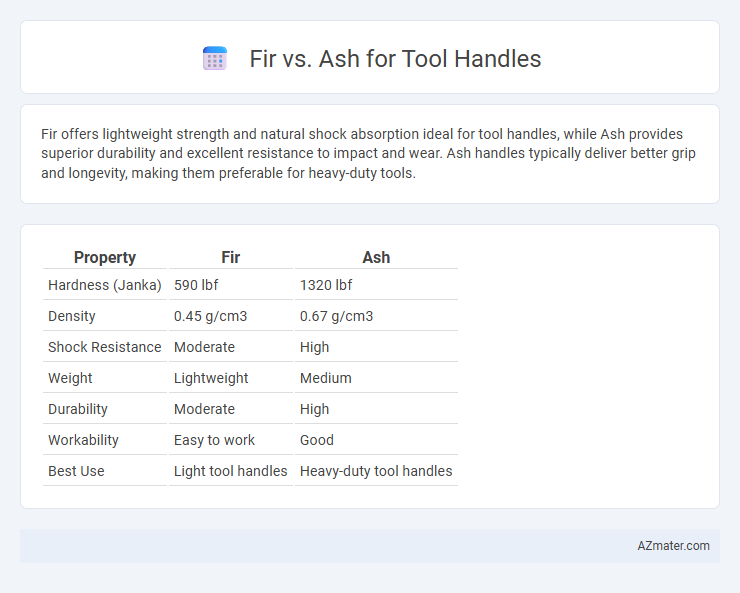Fir offers lightweight strength and natural shock absorption ideal for tool handles, while Ash provides superior durability and excellent resistance to impact and wear. Ash handles typically deliver better grip and longevity, making them preferable for heavy-duty tools.
Table of Comparison
| Property | Fir | Ash |
|---|---|---|
| Hardness (Janka) | 590 lbf | 1320 lbf |
| Density | 0.45 g/cm3 | 0.67 g/cm3 |
| Shock Resistance | Moderate | High |
| Weight | Lightweight | Medium |
| Durability | Moderate | High |
| Workability | Easy to work | Good |
| Best Use | Light tool handles | Heavy-duty tool handles |
Introduction to Fir vs Ash for Tool Handles
Fir and ash are popular wood choices for tool handles due to their strength and shock resistance. Ash has a straight grain and excellent elasticity, making it ideal for absorbing vibrations during heavy use. Fir offers a lightweight option with moderate durability, suited for tools requiring less impact resistance.
Key Properties of Fir Wood
Fir wood, known for its excellent strength-to-weight ratio, is a preferred choice for tool handles due to its durability and shock resistance. Its straight grain and fine texture provide stability and comfort during prolonged use, reducing user fatigue. Compared to ash, fir offers slightly lighter weight while maintaining sufficient hardness, making it ideal for hand tools requiring both resilience and ease of handling.
Key Properties of Ash Wood
Ash wood is highly favored for tool handles due to its exceptional toughness, elasticity, and shock resistance, which provide durability and comfort during prolonged use. Its coarse, straight grain enhances strength and reduces the risk of splintering under heavy impact, making it ideal for hammers, axes, and other hand tools. Compared to fir, ash offers superior density and flexibility, ensuring tool handles withstand repeated stress without breaking or deforming.
Strength and Durability Comparison
Ash offers superior strength and durability compared to Fir, making it a preferred choice for tool handles requiring high impact resistance. Its dense grain structure provides enhanced shock absorption and longevity under repetitive stress. Fir, while lighter and easier to work with, lacks the robustness of Ash, resulting in shorter handle lifespan in heavy-duty applications.
Shock Absorption and Flexibility
Fir wood offers impressive shock absorption due to its moderate density and natural grain structure, making it a reliable choice for tool handles that endure repeated impact. Ash is highly valued for its exceptional flexibility and toughness, enabling handles to bend without breaking under stress, which enhances durability during heavy use. Combining both firmness and resilience, ash typically outperforms fir in applications requiring superior shock resistance and longer service life for tool handles.
Weight and Workability
Fir tool handles are lightweight, offering ease of use and reducing user fatigue during extended work periods. Ash, while slightly heavier, provides exceptional strength and durability, making it ideal for heavy-duty tools requiring impact resistance. The workability of fir is superior due to its softer texture, allowing for easier shaping and finishing compared to the denser, harder ash.
Resistance to Moisture and Decay
Ash wood exhibits superior resistance to moisture and decay compared to fir, making it a preferred choice for tool handles exposed to damp conditions. Ash's dense grain structure enhances durability and prevents warping or rotting over time. Fir, while lightweight and economical, is more susceptible to moisture absorption and fungal decay, reducing its lifespan in outdoor or humid environments.
Cost and Availability
Fir offers a cost-effective option for tool handles due to its widespread availability and rapid growth, making it generally less expensive than ash. Ash, valued for its superior strength and shock resistance, tends to be pricier and less abundant, influencing its higher cost and limited availability. Choosing between fir and ash hinges on balancing budget constraints with performance needs in tool handle applications.
Best Uses for Fir and Ash Tool Handles
Fir tool handles offer excellent strength-to-weight ratio and natural resistance to shock, making them ideal for lightweight tools such as axes, hammers, and garden implements that require durability and comfort during prolonged use. Ash tool handles are favored for heavy-duty tools like mauls, splitting axes, and sledgehammers due to their remarkable toughness, flexibility, and ability to absorb impact without cracking. Choosing between fir and ash handles depends on the tool's intended use; fir suits tasks demanding agility and reduced fatigue, while ash excels where maximum strength and resilience are essential.
Final Verdict: Which Wood is Better for Tool Handles?
Fir offers lightweight durability and a straight grain, making it a cost-effective choice for tool handles that require moderate strength and shock absorption. Ash provides superior toughness, exceptional shock resistance, and greater flexibility, ideal for heavy-duty tools subject to frequent impact. For long-lasting, ergonomic tool handles, ash is generally the better wood due to its strength-to-weight ratio and resilience.

Infographic: Fir vs Ash for Tool Handle
 azmater.com
azmater.com